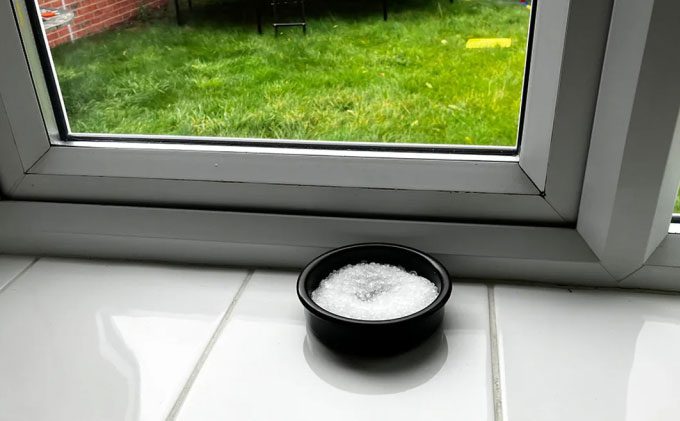Scientists recommend placing a bowl of salt in your home during winter to reduce moisture condensation and help prevent mold.
According to the National Oceanic and Atmospheric Administration (NOAA), condensation does not depend on a specific temperature but rather on the difference between air temperature and dew point. The dew point is the temperature at which dew can form, occurring when air is saturated and cannot hold additional moisture. Any further decrease in temperature will cause the moisture to condense. When moisture in a home or vehicle comes into contact with cold surfaces like windows, it transitions to a liquid state, creating condensation.

Placing a bowl of salt near the window helps reduce moisture condensation. (Photo: IFLScience).
There are several ways to manage moisture condensation, one of which is to place a bowl of salt near windows during the colder months. Andy Ellis, a home and gardening expert at Posh.co.uk, shared with the Mirror that salt has a natural ability to absorb moisture from the air. This will help dry the air, resulting in fewer water droplets forming when it contacts the glass. “This is a very easy tip that requires little effort. Just pour table salt or rock salt into a shallow bowl or small jar. The amount of salt used depends on the size of the window. Generally, the larger the window, the more salt is needed, although usually a small bowl is sufficient“, according to Andy Ellis.
According to chemical engineer John Francis Richardson, a classic example of moisture absorption is deliquescence, which occurs with many solids that dissolve in water, including inorganic salts (e.g., calcium chloride). At a certain temperature, the vapor pressure of a saturated salt solution will be lower than that of pure water, and if it is lower than the partial pressure in the atmosphere, moisture will transfer to the solid surface, part of which will dissolve to form a saturated solution. The process will continue until the partial pressure of the unsaturated solution equals the pressure in the atmosphere. In some cases, the formation of hydrates or higher hydrates of the salt may occur before the liquid phase forms. Liquids (e.g., sulfuric acid) can also undergo deliquescence.
However, according to the German Transportation Information Service, salt only begins to absorb moisture at relatively high humidity. This means that at relative humidity levels up to 74% and 20°C, salt does not absorb a significant amount of moisture. The critical water content of sodium chloride (NaCl) is 0.5% at a relative humidity of 74%. This is the deliquescent moisture point at which salt begins to easily absorb moisture and increases to the point that at a relative humidity of 75%, the salt will dissolve.


















































